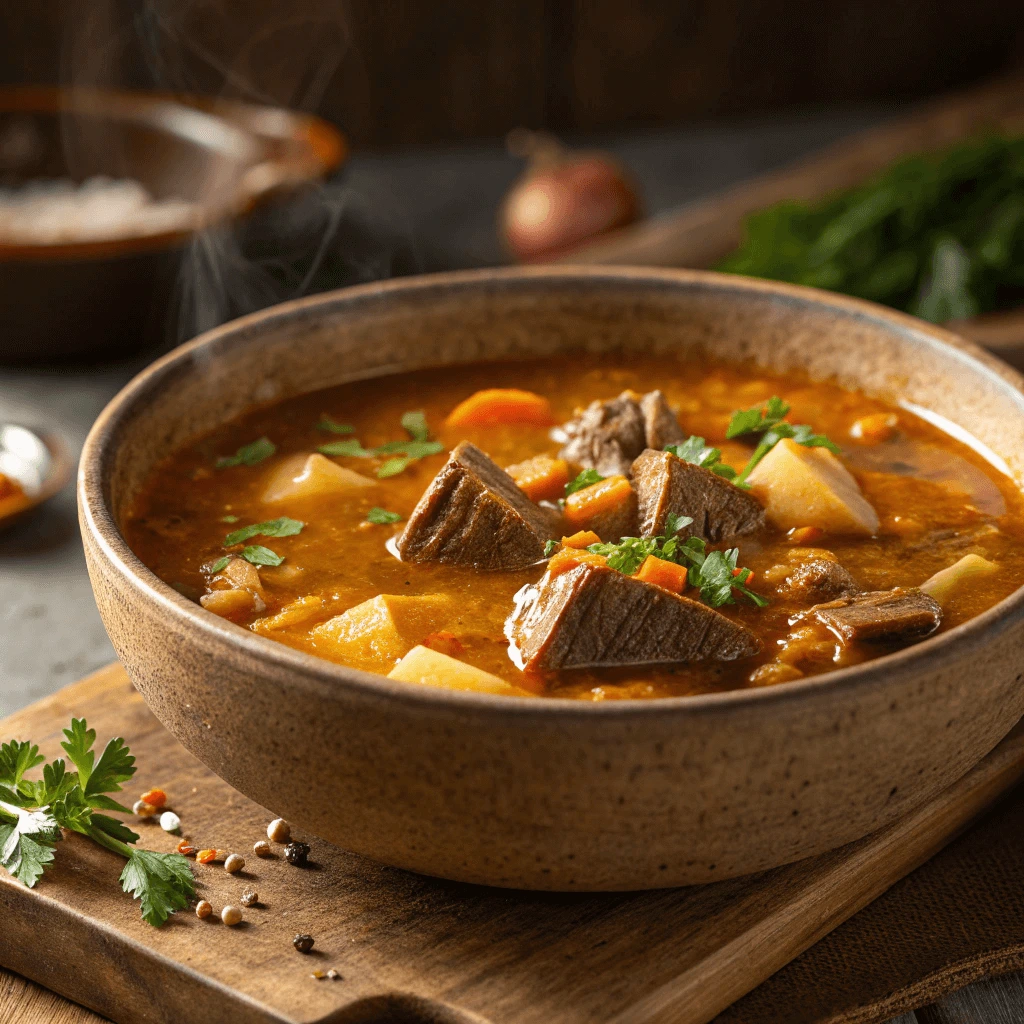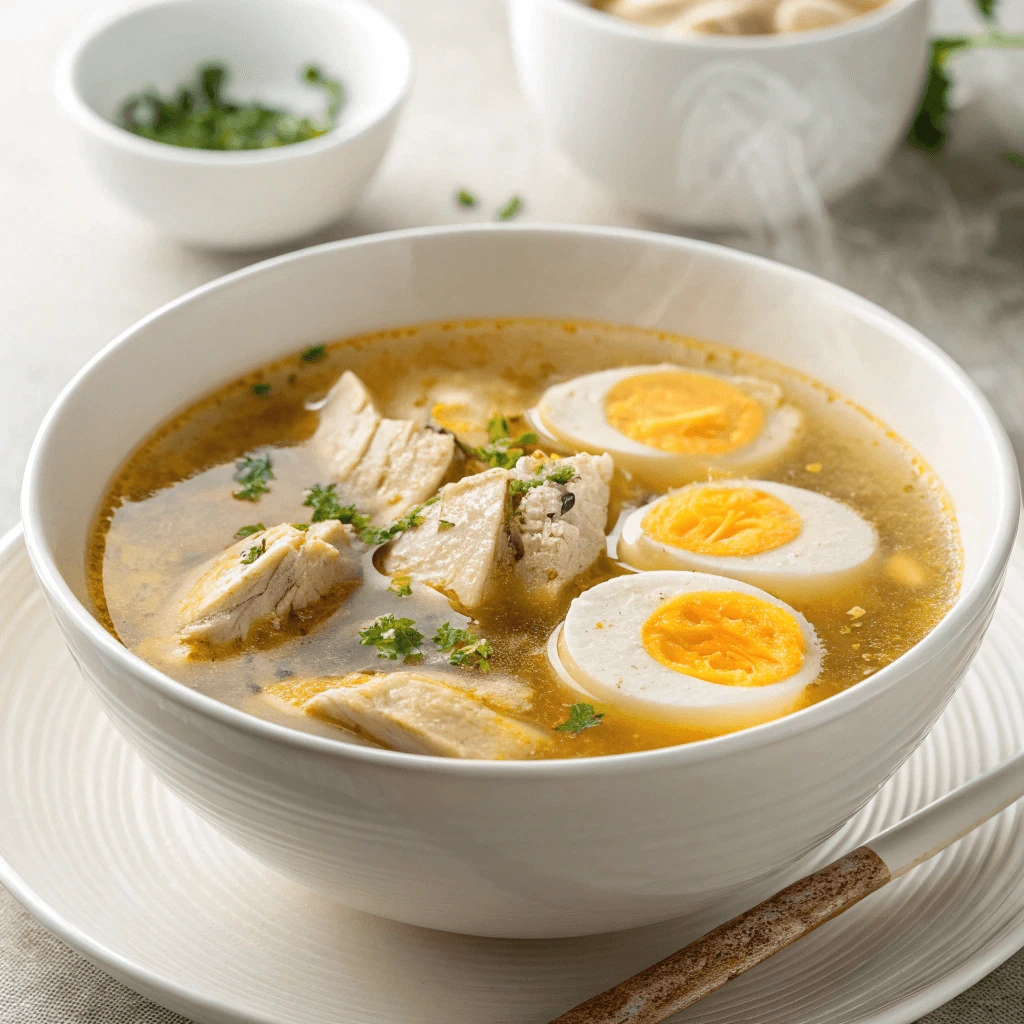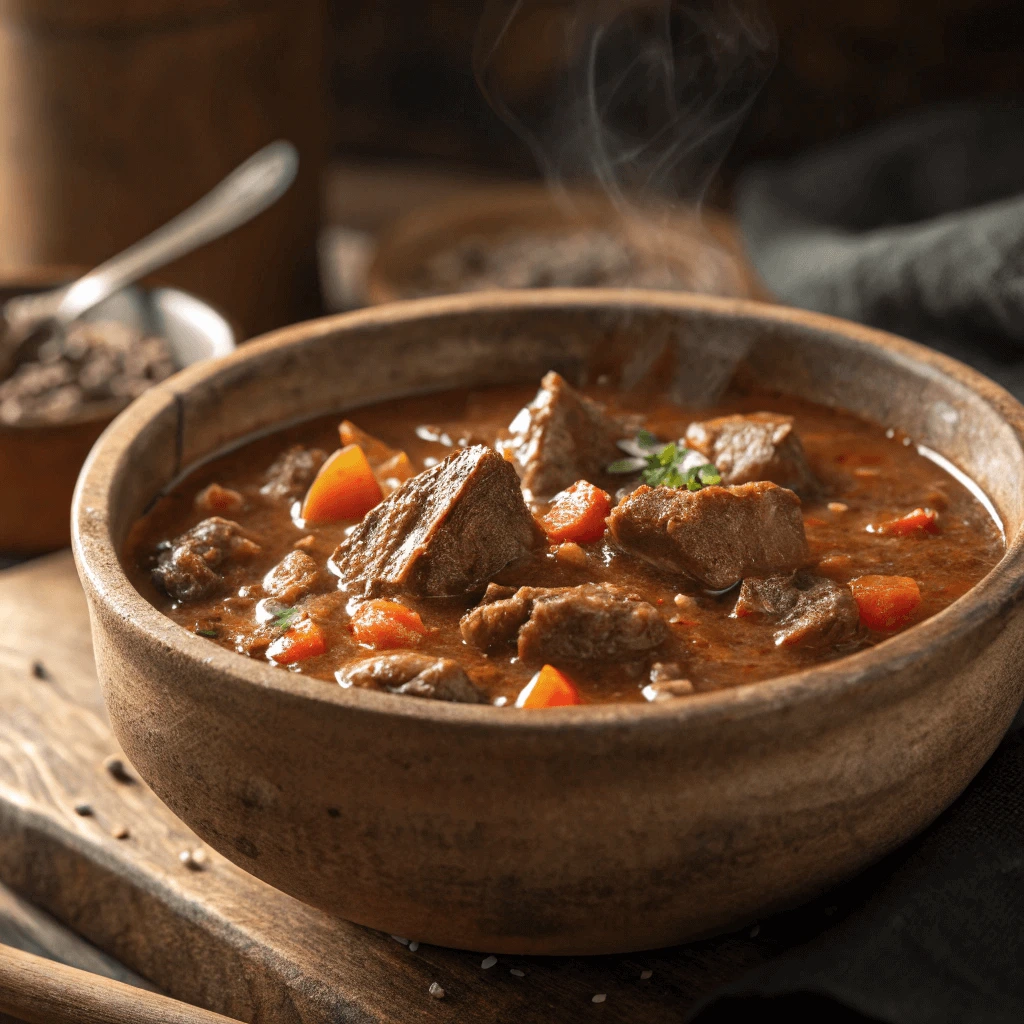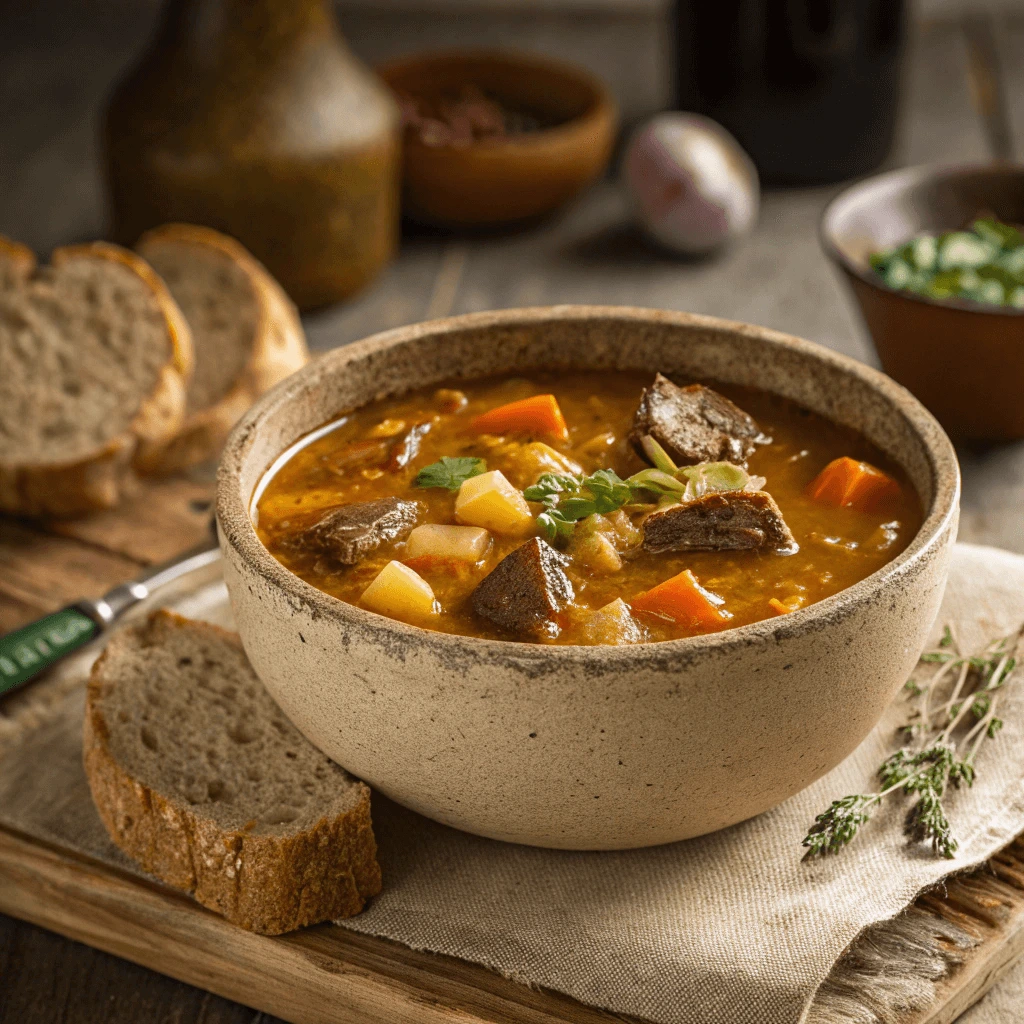If you’re following the carnivore diet, finding flavorful and nourishing soups can be a game changer. The best soup on the carnivore diet should be simple, hearty, and packed with protein, providing all the nutrients your body needs without the carbs. Whether you’re craving a comforting meal after a long day or need something quick and easy to prepare, this carnivore soup recipe has you covered. With a focus on animal-based ingredients, it offers a rich, satisfying flavor that will keep you full and energized. Let’s explore how you can create the perfect soup that aligns with your carnivore lifestyle.
Why Carnivore Soups Are Perfect for This Diet

Hearty Nutrition in a Bowl
Carnivore soups are simple yet incredibly nutritious. Each bowl is packed with essential nutrients that fuel the body and keep you full longer.
Balanced Protein and Fat
Meaty soups made with beef, chicken thighs, or lamb provide complete protein and healthy fat. These nutrients support muscle repair, hormone health, and energy throughout the day. When you slow-cook meats, the protein becomes easier to digest—perfect for those looking for gentle, nourishing meals.
Micronutrients from Broth and Meat
Using bones, skin, and organ meats adds more than flavor. These parts of the animal offer minerals like zinc, iron, and magnesium. You also get B vitamins and other nutrients essential for metabolism and brain health.
Satisfying and Easy to Digest
Soup makes eating meat more comfortable. It’s warm, soft, and hydrating, which helps digestion and reduces strain on your stomach. You feel full, satisfied, and energized—without needing carbs or additives.
Hearty carnivore diet soups deliver everything your body needs in a warm, flavorful bowl. They’re ideal for daily meals, especially when you want something nourishing, simple, and satisfying.
Simplicity and Digestive Comfort
Carnivore soups shine not just for their taste but also for their simplicity and how easy they are on the digestive system. These meals remove common dietary irritants and focus on nutrient-rich ingredients that the body can handle with ease.
Fewer Ingredients, Fewer Problems
Carnivore diet soups use minimal ingredients—typically meat, bones, fat, and salt. By removing vegetables, grains, and processed seasonings, you eliminate many potential gut irritants. This simplicity allows your digestive system to rest and recover.
Warm, Soft Foods Aid Digestion
Soups made from slow-cooked meat and broth are naturally soft and warm, making them easier for the stomach to process. The warmth of the liquid helps relax the digestive tract, while the moisture keeps everything moving smoothly. For those with sensitive digestion, soups offer a soothing solution.
Easy on the Stomach, Full of Nutrition
While simple, these soups don’t compromise on nutrition. They deliver healthy fats, complete proteins, and vital minerals without overwhelming your gut. People transitioning into a carnivore lifestyle often find soups the most comfortable way to eat more meat—especially during the early adjustment phase.
Easy for Meal Prep and Busy Schedules
Hearty carnivore diet soups are a smart choice for those with limited time to cook. With a bit of planning, you can prepare nourishing, protein-rich meals that fit neatly into your week—without the stress.
Batch Cooking Saves Time
Making a large pot of carnivore soup lets you prepare multiple servings at once. You can portion the soup into individual containers and refrigerate or freeze them for later. This eliminates the need to cook every day and ensures you always have a satisfying meal ready when hunger strikes.
Minimal Ingredients, Maximum Efficiency
Carnivore soups typically use just a few core ingredients like beef, chicken, fat, salt, and water. These staples require little prep, and many of them can cook together in one pot. Fewer ingredients also mean less cleanup, which helps streamline your routine.
Perfect for Busy or On-the-Go Lifestyles
Whether you work full-time, parent young children, or just prefer simplicity, carnivore soups make sticking to your diet easier. Just heat and eat—no fancy tools or long recipes needed. This convenience supports consistency and helps you stay on track, even during your busiest weeks.
Best Ingredients for Hearty Carnivore Soup Recipes
Choosing the Right Meats
Selecting the best meats for your carnivore soup plays a key role in both nutrition and flavor. The right combination of cuts can elevate your soup from basic to deeply satisfying while supporting your dietary goals.
Opt for Fatty, Flavorful Cuts
Fatty cuts like beef chuck, oxtail, or chicken thighs bring richness and depth to your soup. These cuts don’t just taste better—they also help you meet your daily fat requirements, which is important for energy on the carnivore diet. Bone-in meats also release extra flavor and nutrients as they simmer.
Include a Variety of Meats for Balance
Mixing different types of meat creates a more balanced nutrient profile. Beef offers iron and zinc, while chicken provides collagen and a softer texture. Adding lamb, duck, or bison occasionally keeps your meals interesting without compromising the carnivore principles. Variety also supports more complete amino acid intake.
Add Organ Meats for Micronutrient Density
While organ meats like liver, heart, or kidney can be intense in flavor, they pack a serious nutritional punch. Including small amounts in your soups helps boost your intake of vitamin A, B vitamins, and important minerals like selenium. If the taste feels overwhelming, blend them with more neutral cuts like ground beef to soften the flavor.
Bone Broth Without Additives
A well-made bone broth is the heart of many hearty carnivore diet soups. When prepared simply and without additives, it delivers deep flavor, nourishing benefits, and natural richness—all from pure animal-based ingredients.
Why Skip Store-Bought Broths
Most commercial broths contain unwanted ingredients like vegetable oils, sugars, preservatives, or flavor enhancers. These additives can interfere with the goals of a strict carnivore diet. Instead of relying on packaged options, you can prepare a cleaner, healthier version at home using basic bones, water, and salt.
Choosing the Best Bones for Homemade Broth
Use marrow bones, knuckles, neck bones, or oxtail for a rich, nutrient-packed broth. These cuts release essential minerals like calcium, magnesium, and phosphorus during slow cooking. Roasting the bones before simmering enhances the flavor and color of your broth naturally, without needing synthetic flavorings.
Cooking Tips for Maximum Benefit
Simmer your bones low and slow—ideally for 8 to 24 hours. A stovetop, slow cooker, or pressure cooker all work well depending on your schedule. Keep the temperature gentle to draw out the nutrients gradually. Skim the surface occasionally to remove impurities, and strain the finished broth for a smooth, clean result.
You can store bone broth in glass jars or silicone freezer molds for convenient future use. When heated, it creates a soothing base that pairs perfectly with meats and animal fats, helping you stay satisfied while sticking to your clean carnivore goals.
Animal Fats for Flavor and Fuel
Animal fats serve a dual purpose in hearty carnivore diet soups—they bring rich, satisfying flavor while providing the dense energy your body needs to thrive on a low-carb, meat-focused diet.
Why Fat Matters on the Carnivore Diet
Fat becomes your body’s primary energy source when you eliminate carbohydrates. By including high-quality animal fats like tallow, beef drippings, duck fat, or rendered chicken skin in your soups, you help stabilize your energy levels and feel full longer. These fats also support hormone production and brain function, which are essential for overall wellness.
Boosting Flavor Naturally
Animal fats act as flavor carriers. When you sauté meats or simmer bone broth with fat, the soup takes on a deep, savory richness that can’t be achieved with lean cuts alone. Adding extra fat during cooking—such as spooning in beef tallow or leaving chicken skin on—builds complexity without needing spices or plant-based seasonings.
Choosing the Right Fats
Each fat brings a unique quality to your soup. Beef tallow adds bold, hearty richness. Duck fat delivers a silky mouthfeel and slightly sweet flavor. Chicken fat (also known as schmaltz) contributes a lighter taste while still providing a nourishing boost. Choose fats based on the meat you’re using or the flavor profile you enjoy most.
Seasoning and Flavoring Without Plants

Salt and Electrolyte Support
Maintaining electrolyte balance is crucial when following the carnivore diet. Since you’re not eating carb-rich foods that help retain water, your body flushes out sodium and other electrolytes more quickly. Soups are a smart way to replenish them naturally.
Why Electrolytes Matter
Electrolytes like sodium, potassium, and magnesium regulate your hydration, nerve function, and muscle contractions. Without enough of them, you may experience fatigue, dizziness, headaches, or even cramps—commonly known as “keto flu” symptoms. Carnivore soups, especially when made with salt-rich broths and fatty cuts, help restore that balance with every spoonful.
Choosing the Right Salt
Not all salts are equal. Instead of refined table salt, try using mineral-rich options like sea salt, Himalayan pink salt, or Redmond Real Salt. These varieties contain trace minerals that support hydration and energy without additives. Add salt directly to the broth, or sprinkle it on top when serving to enhance both flavor and function.
Adding Other Electrolyte Sources
Besides salt, you can boost your electrolyte levels with ingredients like bone broth (rich in sodium and potassium), egg yolks, or organ meats like liver and heart, which supply magnesium and other essential minerals. If needed, you can supplement with small amounts of potassium or magnesium in capsule or powder form—but focus on food-first solutions through your soup recipes.
Optional Enhancers for Depth
Even within the simplicity of the carnivore diet, you can still enjoy bold, rich flavors. While many carnivore purists stick to salt and fat alone, others find optional additions can elevate a soup’s taste and nutrition—without compromising the diet’s core principles.
Using Animal-Based Flavor Boosters
Natural animal-based ingredients offer powerful depth. Roasted marrow bones, beef drippings, chicken skin, or tallow can infuse soups with extra richness. Try browning meats or searing bones before simmering. This Maillard reaction brings out deep umami notes and creates a more satisfying mouthfeel. Don’t discard the crispy bits at the bottom of your pan—they’re flavor gold.
Minimal Herbs for Transitioners
If you’re transitioning into the carnivore lifestyle or prefer a gentler entry point, a few mild herbs like rosemary, thyme, or bay leaf may help bridge the gap without adding carbs. These herbs don’t overpower the meat and are easy to strain out after cooking. They offer a familiar scent and taste for those adapting from a more omnivorous palate.
Avoiding Additives and Hidden Fillers
It’s easy to fall into the trap of using store-bought broth cubes, spice blends, or condiments—but most of these contain unwanted fillers, sugars, or seed oils. Instead, enhance your soup naturally with slow-cooked fats, collagen-rich cuts, and bones. Keep it clean and whole-food based to stay aligned with carnivore principles.
Optional enhancers aren’t required, but they can enrich your experience and make hearty carnivore diet soups even more enjoyable—especially if you’re preparing them for family members who are easing into the lifestyle.
Building Flavor Through Cooking Technique
Great carnivore soups don’t rely on vegetables or spices for flavor—they develop richness through technique. The right cooking methods can transform simple ingredients into bold, satisfying meals.
Browning for Depth
Start by searing meats and bones in a hot pan or pot before adding liquid. This caramelizes surface proteins and creates browned bits (fond) that dissolve into the broth. The result is a deeper, more complex flavor without needing any plant-based additions.
Slow Cooking for Intensity
Simmering soups low and slow for several hours draws out collagen, marrow, and gelatin from bones. This technique creates a silky mouthfeel and boosts the umami taste. Use a stovetop or slow cooker to allow flavors to meld naturally over time.
Fat Layering for Richness
Incorporate animal fats like tallow, butter, or rendered skin at different stages of cooking. Fat captures and carries flavor, making every bite more satisfying. Add some at the start for browning, and finish with a drizzle before serving to enhance aroma and taste.
Cooking Methods for Carnivore Diet Soups
Simmering on the Stove
Simmering on the stovetop remains one of the most traditional and effective ways to create rich, flavorful carnivore diet soups. It allows precise control over heat, timing, and ingredients, resulting in deeply nourishing meals made entirely from animal-based sources.
Start With a Strong Base
Begin by adding bones, meat, and animal fats to a large stockpot. Choose cuts like beef shank, oxtail, chicken thighs, or marrow bones. Cover the ingredients with water, and bring it all to a gentle boil. Once bubbles rise to the surface, reduce the heat immediately to a steady simmer. This step helps prevent cloudy broth and encourages the release of collagen, marrow, and essential nutrients.
Control the Simmer for Maximum Flavor
Let the soup simmer uncovered or partially covered for several hours—typically between 4 to 8 depending on the cuts used. Monitor the pot occasionally to skim off any foam or impurities that rise to the surface. This improves clarity and taste. Throughout the process, maintain a low, consistent temperature. Avoid rapid boiling, which can make the broth taste harsh and break down delicate fats too quickly.
Adjust, Taste, and Finish
As the soup simmers, taste it periodically. Add unrefined salt as needed to support electrolyte balance and bring out the natural flavors of the meat. In the final hour, you can add more fatty cuts or leftover cooked meats for extra heartiness. Once the broth reaches your desired richness, remove bones and shred any tender meat back into the pot. Finish with a small scoop of tallow or butter for added depth and energy.
Slow Cooker for Hands-Off Cooking
The slow cooker is a perfect companion for making hearty carnivore diet soups. It offers convenience, consistent heat, and the ability to walk away while your soup gently simmers for hours. This method suits busy lifestyles without sacrificing nutrition or flavor.
Effortless Meal Prep with Minimal Supervision
To start, simply place your chosen meats, bones, and fats into the slow cooker. Cuts like beef chuck roast, short ribs, chicken thighs with skin, or oxtail work particularly well. Pour in filtered water to cover the ingredients and add a generous pinch of unrefined salt. Then, set your slow cooker to low and let it work its magic for 8 to 12 hours. You don’t need to stir or monitor constantly—the slow cooker does the job with minimal oversight.
Extracting Nutrients While You Work or Sleep
The gentle, extended cooking time helps extract collagen, gelatin, and vital minerals from bones and connective tissues. It also allows tough cuts to become fork-tender, breaking down into a rich, nourishing broth. This slow process preserves the integrity of animal fats while blending flavors naturally. You can even set it overnight and wake up to a warm, ready-to-eat soup.
Tips for Better Flavor and Texture
For added depth, sear meat in a hot pan before transferring it to the slow cooker. This browning step builds flavor that might otherwise be lost in low-and-slow cooking. You can also add extra fats—like tallow or butter—toward the end of cooking to boost richness and energy. Once finished, strain out bones, shred tender meat, and return it to the broth. The result is a satisfying, low-effort soup packed with everything your carnivore body needs.
Pressure Cooker for Speed and Nutrition
A pressure cooker is one of the most efficient tools for making hearty carnivore diet soups quickly without sacrificing flavor or nutritional value. It delivers tender meat and rich broth in a fraction of the time required by traditional cooking methods.
Cook Nutritious Soups in Record Time
Pressure cookers use steam and sealed heat to dramatically cut down cooking time. You can turn tough cuts like beef shank, oxtail, or pork shoulder into tender, flavorful soup in under an hour. Bones that usually need a long simmer will release collagen and minerals much faster under pressure. This rapid cooking process makes it ideal for busy carnivore dieters who want a nutrient-dense meal without waiting all day.
Preserve Nutrients with Shorter Cooking Times
Unlike slow or extended stovetop methods, pressure cooking helps preserve delicate nutrients. Vitamins, amino acids, and electrolytes remain more intact due to the shorter exposure to heat. By sealing in moisture and pressure, the cooker helps lock flavors and nourishment directly into the broth. This makes your carnivore soup not just quicker but also more nourishing.
Easy to Use and Clean
Modern electric pressure cookers like the Instant Pot make the process simple. You just add your meats, bones, salt, and water, set your cooking time, and let the device handle the rest. There’s no need to monitor or stir. Once it finishes, you can allow the pressure to release naturally or do a quick release depending on your timeline. Cleanup is easy, too—most parts are dishwasher-safe.
Carnivore Soup Recipes You’ll Want to Try

Ground Beef and Bone Broth Soup
This comforting soup combines two carnivore staples—ground beef and bone broth—into a warm, nourishing meal that’s simple to prepare and rich in flavor.
Why Ground Beef Is a Great Base
Ground beef is affordable, quick to cook, and easy to digest. Its soft texture works well in soups, breaking apart into bite-sized pieces that blend into the broth. Opt for higher-fat varieties like 80/20 for extra richness and energy.
Benefits of Homemade Bone Broth
Bone broth provides essential nutrients like collagen, gelatin, and electrolytes. Simmer beef or chicken bones for 12 to 24 hours with just water and salt. This draws out deep flavor and nutrients without any additives. The result is a rich, nourishing base that supports gut, joint, and skin health.
Optional Add-Ins for Depth
Boost flavor and nutrition by adding egg yolks, beef fat, or crumbled cooked liver. A sprinkle of sea salt or a touch of marrow can also elevate the taste. These small touches make the soup even more satisfying without straying from carnivore principles.
Chicken Thigh Soup with Skin and Fat
Chicken thighs make an excellent choice for carnivore soups thanks to their rich flavor and higher fat content compared to leaner cuts. Using skin-on thighs adds both moisture and depth to your soup, ensuring every bite feels hearty and satisfying.
Why Choose Chicken Thighs?
Chicken thighs provide tender meat and a natural fat source that keeps the soup rich and flavorful. Their dark meat contains more nutrients, including iron and zinc, which support overall health. Unlike chicken breast, thighs don’t dry out easily, making them ideal for slow simmering.
The Importance of Skin and Fat
Keeping the skin on during cooking releases flavorful fats into the broth, enhancing both taste and mouthfeel. This animal fat fuels energy levels on a low-carb carnivore diet and helps you feel full longer. You’ll notice a silky texture in the soup, which makes it comforting and nourishing.
Cooking Tips for Best Results
Start by browning the thighs skin-side down in the pot to render some fat and develop a golden crust. Then add water or homemade bone broth and simmer gently for at least an hour to allow flavors to meld. You can shred the meat off the bone before serving, making the soup easier to eat.
Adding salt throughout cooking helps bring out the natural flavors. For added nutrition, consider stirring in some chicken drippings or marrow if available. These elements deepen the richness without compromising the simplicity of the dish.
Organ Meat Soup for Nutritional Power
When searching for the best soup on the carnivore diet, organ meat soup stands out as a top choice. Organ meats such as liver, heart, and kidneys offer unmatched nutrient density that supports overall health and vitality. Including these nutrient-rich meats in your soup ensures you get essential vitamins and minerals that many other foods lack.
Why Organ Meats Make the Best Soup on the Carnivore Diet
Organ meats provide the foundation for the best soup on the carnivore diet because they deliver a powerful nutritional boost. Liver is packed with vitamin A, B vitamins, and iron, while heart supplies CoQ10 and zinc. Kidneys contribute selenium and important trace minerals. These nutrients are essential for energy, immune function, and cellular repair—making organ meat soup an ideal meal.
How to Balance Flavor While Creating the Best Soup on the Carnivore Diet
Many people hesitate to eat organ meats due to their strong taste. The key to making the best soup on the carnivore diet with organ meats is balancing flavor and nutrition. Combine organ meats with milder cuts like beef or chicken thighs to create a more approachable flavor. Slow cooking helps mellow the intense taste of organs while preserving their nutritional value.
Cooking Techniques for the Best Soup on the Carnivore Diet Using Organ Meats
To make the best soup on the carnivore diet, start by cleaning and trimming your organ meats well. Add them to simmering bone broth or plain water alongside other meat cuts. Cooking the soup slowly at a low temperature ensures tender texture and rich flavor without overcooking, which can make organ meats bitter.
Shred or chop the cooked organ meats before serving for easier eating. Season simply with salt and optional animal fats to enhance taste and richness. This organ meat soup stands as one of the most nourishing and flavorful options for anyone looking to enjoy the best soup on the carnivore diet.
Conclusion
The best soup on the carnivore diet combines simplicity, hearty nutrition, and delicious flavors that satisfy both body and soul. These soups harness the power of quality meats, rich bone broth, and essential fats to fuel your body without carbs or additives. Whether you’re batch cooking for convenience or seeking comforting meals, carnivore soups offer unmatched nourishment and taste. Embrace these simple, nourishing recipes to enjoy the full benefits of the carnivore lifestyle—delicious, easy, and truly satisfying.
